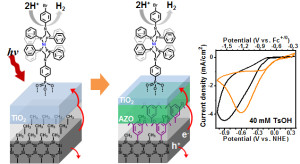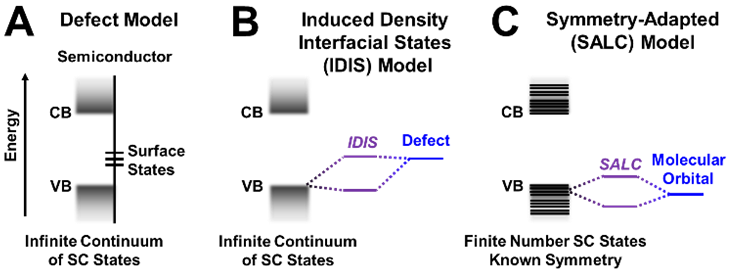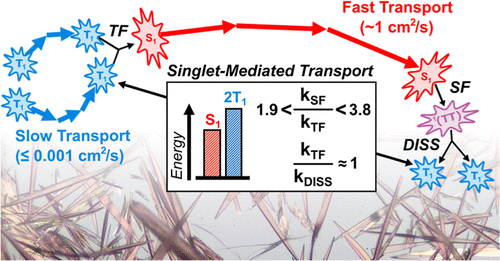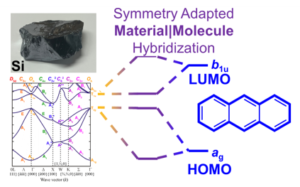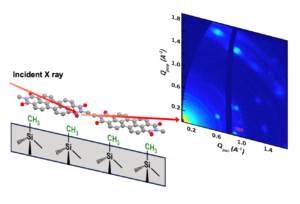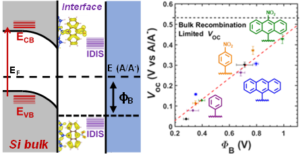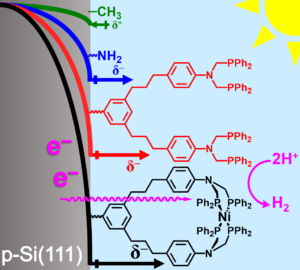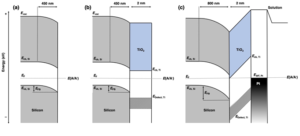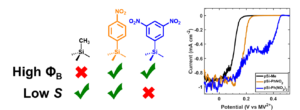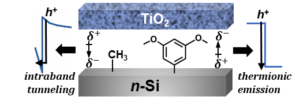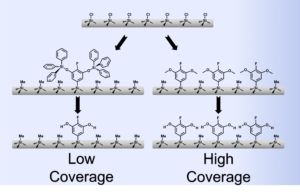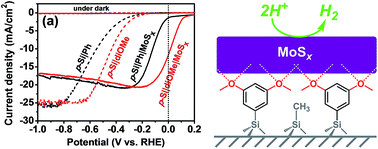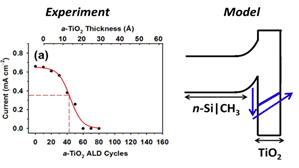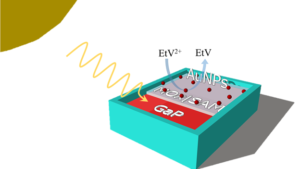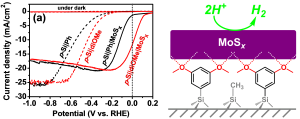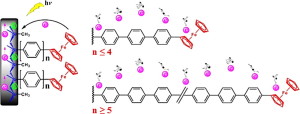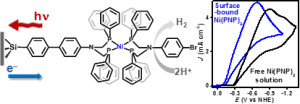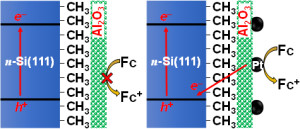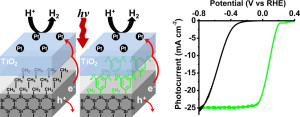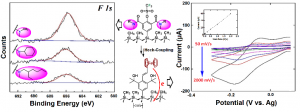Hybrid Molecular/Materials Approach to Semiconductor Catalysis
“Solar Fuels” is a multidisciplinary area of research that involves using the energy provided by sunlight to carry out chemical reactions. Nature has crafted its own version of this process, utilizing photosystem II (PSII) to execute the light-driven oxidation of water. The system consists of two parts: a light-absorber (Mg-porphyrin) and a catalyst (Mn-O cubane).
One important challenge in chemical research today is to simulate some version of ‘Artificial Photosynthesis’ by interfacing light absorbing materials (Si, GaP, CdTe) with molecular, metallic or materials catalysts in novel ways that preserve the essential function of both components.
The goal of our group is to investigate new ways to build hybrid molecular/materials interfaces to integrate and stabilize each component. The resulting passivated and functionalized semiconductor could be used to generate fuels (e.g. dihydrogen, alcohols) directly from sunlight in an integrated device. For example, we recently showed that H2 photogeneration can be achieved using a combination of materials and molecular chemistry as shown below in a p-Si(111)|diOMePh|AZO|TiO2|PNP-Ni-PNP photocathode.
We are particularly interested in the role of hybridization of surface-attached molecules with the semiconductor band-structure. As visualized below, we take an atomistic and molecular approach to understanding the bonding (hybridization) between, and how the symmetry of molecular orbitals determines their bonding with the underlying material.
![]()
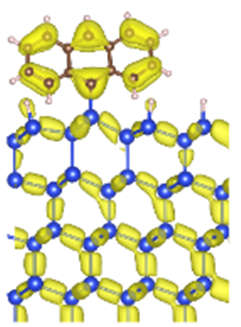 The approach is effectively building interfacial SALCs — just like Harry Gray’s inorganic Ligand Field Theory, or Mulliken’s organic MO theory — except using a combination of solid-state wavefunctions (plane-waves) and standard MO’s. This enables us to finely tune and enhance the function of electron transfer and energy transfer across organic|inorganic interfaces.
The approach is effectively building interfacial SALCs — just like Harry Gray’s inorganic Ligand Field Theory, or Mulliken’s organic MO theory — except using a combination of solid-state wavefunctions (plane-waves) and standard MO’s. This enables us to finely tune and enhance the function of electron transfer and energy transfer across organic|inorganic interfaces.
Related techniques include organic synthesis, inorganic synthesis, atomic layer deposition (ALD), X-ray photoelectron spectroscopy (XPS), electrochemistry and photo-electrochemistry.
Relevant Publications
HJ Kim and M. J. Rose*. Role of Interfacial Potential Drops on Redox-Couple Dependent Voltages using Hybridized Si(111)-(Bis)Anthracene Photoelectrodes.
ChemElectroChem. 2024, 11, e202400468 Link
T. S. Volek, M. A. Verkamp, G. N. Ruiz, A. J. Staat, B. C. Li, M. J. Rose, J. D. Eaves and S. T. Roberts. Slowed Singlet Exciton Fission Enhances Triplet Exciton Transport in Select Perylenediimide Crystals. J. Am. Chem. Soc. 2024, 146, 29575.
C. D. Hallock and M. J. Rose. Electrochemical Impedance of Well-Passivated Semiconductors Reveals Bandgaps, Fermi Levels and Interfacial Density of States. J. Am. Chem. Soc. 2024, 146, 18989-18998. Link
M. J. Rose. Semiconductor Band Structure, Symmetry & Interface Hybridization for the Chemist. J. Am. Chem. Soc. 2024, 146, 5735-5748. Link
J. M. Strain, G. N. Ruiz, S. T. Roberts and M. J. Rose. Methylation of Si(111) Modulates Molecular Orientation in Perylenediimide Thin Films. Langmuir 2024, 40, 2519-2530. Link
J. M. Gurrentz, K. A. Jarvis, I. R. Gearba-Dolocan and M. J. Rose. Atomic Layer Deposited Al2O3 as a Protective Overlayer for Focused Ion Beam Preparation of Plan-View STEM Samples. Ultramicroscopy 2022, 239, 113562. Link
J. M. Gurrentz and M. J. Rose. Covalent Attachment of Polyoxometalates to Passivated Si(111) Substrates: A Stable and Electronic Defect-Free Si|POM Platform. J. Phys. Chem. C. 2021, 125, 14287-14298. Link

D. G. Boucher, K. L. Kearney, E. Ertekin and M. J. Rose. Tuning p-Si(111) Photovoltage via Molecule|Semiconductor Electronic Coupling. J. Am. Chem. Soc. 2021, 143, 2567-2580. Link
J. M. Gurrentz and M. J. Rose. Non-Catalytic Benefits of Ni(II) Binding to an Si(111)-PNP Construct for Photoelectrochemical Hydrogen Evolution Reaction: Metal Ion Induced Flat Band Potential Modulation. J. Am. Chem. Soc. 2020, 142, 5657-5667. Link
R. T. Perarek, D. G. Boucher, N. R. Neale and M. J. Rose. Energetic Tug-of-War between Pt and Leaky TiO2: Positive and Negative Effects on the Function of Molecularly Modified p-Si(111)|TiO2|Pt Photocathodes. ChemElectroChem 2020, 7, 1048-1056. Link
D. G. Boucher, J. R. Speller, R. Han, F. E. Osterloh and M. J. Rose. Decoupling Effects of Surface Recombination and Barrier Height on p-Si(111) Photovoltage in Semiconductor|Liquid Junctions via Molecular Dipoles and Metal Oxides. ACS Appl. Energy Mater. 2019, 2, 66-79. Link
R. T. Pekarek, K. L. Kearney, B. M. Simon, E. Ertekin, A. Rockett and M. J. Rose. Identifying Charge Transfer Mechanisms at Semiconductor Heterojunctions with Molecular Surface Dipoles and Multiscale Computational Modeling. J. Am. Chem. Soc. 2018, 140, 13223-13232. Link
R. T. Pekarek and M. J. Rose. Synthetic Insights into Surface Functionalization of Si(111)–R Photoelectrodes: Steric Control and Deprotection of Molecular Passivating Layers. Langmuir 2018, 34, 6327-6337. Link
D. W. Redman, M. J. Rose and K. J. Stevenson. Electrodeposition of Amorphous Molybdenum Chalcogenides from Ionic Liquids and Their Activity for the Hydrogen Evolution Reaction. Langmuir 2017, 33, 9354-9360. Link
H. J. Kim*, K. L. Kearney*, L. H. Le, Z. J. Haber, A. A. Rockett and M. J. Rose. Charge-Transfer through Ultrathin Film TiO2 on n-Si(111) Photoelectrodes: Experimental and Theoretical Investigation of Electric Field-Enhanced Transport with a Non-Aqueous Redox Couple. J. Phys. Chem. C 2016, 25697-25708. Link
O. M. Williams, J. Shi and M. J. Rose. Photoelectrochemical Study of p-GaP(100)|ZnO|AuNP Devices: Strategies for Enhanced Electron Transfer and Aqueous Catalysis. Chem. Commun. 2016, 9145-9148. Link
D. R. Redman, H. J. Kim, K. J. Stevenson and M. J. Rose. Photo-Assisted Electrodeposition of MoSx from Ionic Liquids on Organic-Functionalized Silicon Photoelectrodes for H2 Generation. J. Mater. Chem. A. 2016, 7027-7035. Link
H. J. Kim, J. Seo and M. J. Rose. H2 Photogeneration Using a Phosphonate-Anchored Ni-PNP Catalyst on a Band-Edge-Modified p-Si(111)|AZO Construct. ACS Appl. Mater. Interfaces 2016, 8, 1061-1066. Link
F. Li, V. M. Basile and M. J. Rose. Electron Transfer through Surface-Grown, Ferrocene-Capped Oligophenylene Molecular Wires (5-50 A) on n-Si(111) Photoelectrodes. Langmuir 2015, 31, 7712-7716. Link
J. Seo, R. T. Pekarek and M. J. Rose. Photoelectrochemical Operation of a Surface-Bound, Nickel-Phosphine H2 Evolution Catalyst on p-Si(111): A Molecular Semiconductor|Catalyst Construct. Chem. Commun. 2015, 51, 13264-13267. Link
H. J. Kim, K. L. Kearney. L. Le, R. T. Pekarek and M. J. Rose. Platinum-Enhanced Electron Transfer through Ultra-Thin Film Aluminum Oxide (Al2O3) on Si(111) Photoelectrodes. ACS Appl. Mat. Intfc. 2015, 8572-8584. Link
J. Seo, H. J. Kim, R. T. Pekarek and M. J. Rose. Hybrid Organic/Inorganic Band-Edge Modulation of p-Si(111) Photoelectrodes: Effects of R, Metal Oxide, and Pt on H2 Generation. J. Am. Chem. Soc. 2015, 137, 3173-3176. Link
F. Li, V. M. Basile, R. T. Pekarek and M. J. Rose. Steric Spacing of Molecular Linkers on Passivated Si(111) Photoelectrodes. ACS Appl. Mater. Interfaces. 2014, 6, 20557-20568. Link


